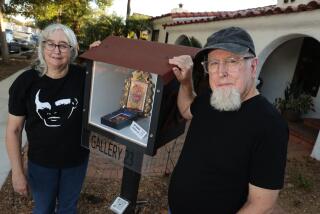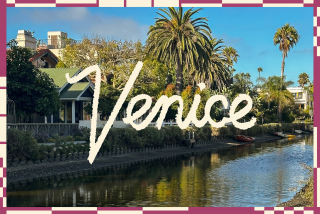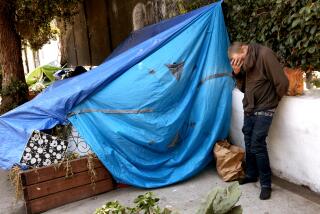WESTSIDE COVER STORY : Creative Touch : Venice Arts Program Draws on Local Talent to Help Young People Develop Self-Esteem
- Share via
Venice artist Bettina Kleemann enfolds an 8-year-old’s hands in hers and gently guides the girl’s fingers onto a round slab of wet clay. There, with small, feathering strokes, teacher and student attach carefully rolled coils of the steel-gray material.
“Put some water on your fingers to connect the coils to each other,” whispers Kleemann, her head level with her tiny charge, one of five children learning the art of coil pot-making at Kleemann’s studio. “You want to roll the coils better. Otherwise they get very uneven, thin and won’t hold.”
The six-week class is part of an all-volunteer project in which professional artists teach their passion to underprivileged young people in the community. Called the Venice Arts Mecca, the nonprofit, multidisciplinary arts program was founded in 1992 by actor and activist Bingwa, who felt that if Venice children could sample the creative rewards of the arts, they might resist the destructive offerings of the streets.
This month the group, which serves about 130 young people ages 3 to 24, expanded its program from photography, painting, ceramics and video-making to include theater, voice, dance and a pops orchestra. The new classes are intended to entice more teen-agers to join.
The activities, says Bingwa, bring together disparate worlds.
“The greatest thing about this community is its artists,” says Bingwa, 42. The program encourages artists “to deal with the community around them, and the artists get support and a rapport from people in the community in return,” he said. “It opens people up, like a flowering. Everyone is willing to give in their own way.”
Some of the fruits of the program are exhibited once or twice a year in black-and-white photography shows. Since its inception, the Venice Arts Mecca has had four photo exhibits, the latest of which took place in the Venice post office.
The images, mounted and framed for sale, have included the photographers’ impressions of their neighborhoods, self-portraits and shots of the city of Oakland, a trip Bingwa chaperoned last year. Sales of the photos have brought in a few thousand dollars for the group, and the exhibits have been well attended and warmly received, says Lynn Warshavsky, president of the Venice Arts Mecca board of directors.
“To see this exhibit makes me really, really impressed by the direction the youth are going in,” said Edward Turner, a 15-year Santa Monica municipal bus driver who attended a September show. He counts some of the photographers among his regular bus passengers. “There are so many negative things these kids can get involved in. . . . These kids are our tomorrow.”
Goodwill in the community is essential if the group is to achieve its most ambitious goal. Arts Mecca, now using a patchwork of donated space and artists’ studios for its classes, wants to transform the controversial and unused Venice Arts Pavilion into a combined community arts and child-care center. The group has taken the first step toward this use for the pavilion by preparing an application to the city of Los Angeles.
The Arts Mecca proposal is unlikely to be the only plan for the pavilion. Other community groups are expected to recommend alternatives for the cavernous building, part of which is used as a police substation. Boardwalk merchants, meanwhile, want the city to raze the building, claiming that it’s an eyesore and attracts drug and gang activity.
It is unclear how the pavilion will fare in a boardwalk renovation plan now being drafted by the city. Councilwoman Ruth Galanter, who has supported Venice Arts Mecca programs, has yet to take a position on the issue.
In the meantime, Arts Mecca artists carry on, “soldiers for the cause,” as Ira McAiley, a choreographer and Venice Arts Mecca board member, puts it.
That dedication is evident in every Arts Mecca workshop and rehearsal. In one of his weekly sessions, painter Terrel Moore stands amid 20 paintbrush-wielding children, all of whom are under 14, in his Venice studio. To the moody tunes of the California band Mazzy Star, the children paint on huge strips of butcher paper taped to the walls. Periodically, they dart to a table lined with paint containers, then return, their brushes weighted down with blues, greens and yellows.
A 9-year-old girl paints her image alongside renderings of a house, a sun, a moon and the inscription, “I like you.” Some of the images painted by other children look like hieroglyphics, still others like Aztec representations of reptiles. In honor of Valentine’s Day, pink, red and blue hearts abound.
“I don’t think most artists will let 15 kids into their studio to throw paint around,” says Moore, 27, painting serpentine designs as several children alongside him mimic his motions. “It’s kind of neat having all these kids know your name.
“I do this for the relationship I have with them,” he says, pausing to tell one small artist that he paints like Jackson Pollock. The young painter, Jamell Lewis, 10, doesn’t understand the reference to the famed abstract artist, and his concentration remains unbroken.
“I really don’t teach them. I just give them the materials and make sure they don’t eat the paint,” Moore says. “They see my paintings and kind of go with the same feelings and some of the same symbols. It’s pure. That’s the bottom line.”
When the two-hour painting session ends, the studio’s canvas floor coverings are coated in a mud-colored slop--the messier the better, for one young artist.
“I love doing the painting,” said Chelsea Rippel, a 7-year-old who also takes ceramics classes. “You can make whatever you want. And what I love most of all is getting the paint on myself.”
*
The new performing arts classes, taught mostly by artists who don’t live in Venice, are aimed at youths age 13 and older. There is a voice class, run by Chrislyn Cross-Moore, a professional singer. African-Haitian dance is taught by professional dancer Jan Marie. And film editor Annette Hunt teaches a video class.
Bingwa runs the theater program. And the pops orchestra, which has recruited two dozen musicians so far, is directed by seasoned conductor Delbert Taylor, music director and arranger for actor and singer Robert Guillaume. Taylor, who has also conducted national and international pops orchestras, offered his services when he met Bingwa and a couple of children selling Arts Mecca calendars at the Venice Farmers Market.
“I am doing this because if there wasn’t a guy like Bingwa when I was a kid, who knows where I’d be today?” says Taylor. He would not have entered the music world, he says, if it weren’t for an actor in his hometown of Dayton, Ohio. “What I like about this group is I know I am going to directly influence the next generation of pop orchestral performers.”
Among the beneficiaries is Pamela Lavelle, a 22-year-old resident of Venice’s Oakwood neighborhood and mother of a 3-year-old girl, Anaise. When she gave birth to her daughter in 1991, she dropped out of Santa Monica College, where she was studying computer science. Many months later, she started taking the Arts Mecca video-making class, then the photography class and, most recently, she joined the orchestra as a cellist.
The training has had an effect. Lavelle plans to return to Santa Monica College this fall--not to study computer science, but to prepare for becoming a music teacher for children.
“I found out I liked the arts and that I am not awful at it,” says Lavelle. “It was very positive for me, helped me grow and focus on what I wanted to do in life. . . . I feel very fortunate.”
Led by Taylor, Lavelle and the other Arts Mecca musicians practice at the Venice United Methodist Church Auditorium on Lincoln Boulevard and Victoria Avenue, where all the performing arts classes are held. The church donated the space to the group.
“These are hard times for teen-agers growing up, particularly with all the gang violence between the kids in Santa Monica and Venice,” says Nelda Tittle, the church’s treasurer.”One Thursday night during choir practice there was a shooting at Lincoln Boulevard and Washington Boulevard. That was a little too close to home.”
*
The arts organization’s first offering, and the one that remains its most popular, is photography. The classes are held every day and are staffed with 12 volunteer photographers. Two children are paired with a photographer for each class, with the instructor guiding them on shoots. Some children have even gone aloft in a helicopter to take aerial shots.
Arts Mecca has set up a darkroom in the basement of the Waldorf apartment building at Westminister Avenue and Oceanfront Walk with donations from, among others, George Lenny, owner of the Waldorf, Frank Lutz, manager of the Jim Morrison apartment building, and the Venice Family Clinic. The 400-square-foot darkroom can accommodate six people, Bingwa says.
A mainstay of the photography program is photographer-volunteer Harry Drinkwater, 75, a Venice resident since 1963.
“What these kids have done in the last two years is just phenomenal,” Drinkwater says. “They made a calendar and printed a hundred prints for the (Venice) post office show that hung for four months. . . . They are working with as much enthusiasm and concern for the community as ever. They have improved their lot.
“It is something they can sell. If it sells, it works. That is completion.”
To improve sales of the photographs, Bingwa sets up shop at the boardwalk on weekends and holidays, selling the work of his students. The most popular photograph is a shot of the Hollywood sign taken from a helicopter by 13-year-old Brooke Aleman. An average day brings in $100, but the burgeoning crowds of summer, he says, promise $300 days.
Photographs sell for $15, with 30% going to the child who took the shot. About 40% of sales from a $10 calendar made with the Oakland photographs goes to the child who sells it. The remaining proceeds go back into the organization to pay for class materials.
Although a number of artists, such as Kleemann and Moore, donate the materials used in their classes, the group still must raise funds to meet operating costs. Last year, Venice Arts Mecca raised roughly $29,000 in cash and received $55,000 in donated materials and equipment, says Warshavsky.
The contributions allowed the group to break even, she said. But with the organization expanding its programs and building a collapsible stage for the orchestra, this year’s operating budget is $200,000.
“We have been working with foundations and organizations, which I am sure will bear fruit in the long term,” says Warshavsky, a 13-year Venice resident.
*
In Bingwa, a Kansas City native who adopted his Swahili name when he was 19, the organization has an experienced director. He ran a similar program in Oakland called the Oakland Theater Ensemble, which was founded by actors in 1974. Bingwa, who studied theater at Merritt College in Oakland, joined the organization two years later. He turned it into a multidisciplinary program and ran it for about 2 1/2 years.
Bingwa had to leave the Oakland program when he became ill with pneumonia and was hospitalized. The theater group, which had been housed in a historic house in Oakland, finally disbanded when the building was sold in 1980. Bingwa worked for a time running youth homes, then moved to Los Angeles in 1981 to pursue an acting career.
“Bingwa is not out for brownie points and he is not an ‘I’ ‘me’ person,” says Jackie Petty-Wright, a lifetime Venice resident who teaches computer classes and has a son, Marques, 7, in the photography classes. “He’s out for the development of human beings. He is breaking down ethnic hostilities in our community through the arts. It’s a better medium to communicate in than body language, something that can get you shot. My 7-year-old son has such incredible self-esteem that he’s dangerous.”
Bingwa receives no pay for his Arts Mecca work. He says he has made ends meet as an actor and waiter at Hal’s in Venice. He has performed in numerous stage plays and bit parts in film and television productions.
He lives in the Jim Morrison apartment building and avoids driving, preferring to ride a bicycle, walk or take the bus. He devotes so much time to Arts Mecca, he says, because he believes Venice’s low-income residents deserve more attention--and resources--from their well-to-do neighbors.
“It’s a lot tougher to sit out there and not do anything,” he says. “I just can’t seem to be able to let things be the way they are. I can’t adjust to it. We have an alternative gang for kids to run with. This is cool, this is acceptable. It’s an alternative way to get that attention you crave at 10 or 11, because that is when it starts.”
Clearly, the artists that Bingwa has called to arms have similar sentiments. Most of them live, work and sell their art in Venice. For Kleemann, 32, who came to Los Angeles in 1991 from Berlin to study with ceramist Michael Frimkess, Venice was an obvious choice. The funky, free-spiritedness of the place fosters creativity. Galleries and working artists make the place visually rich.
Now, Kleemann says, she wants to give something back and--at the same time--pass useful lessons on to young artists.
“With clay, you start with nothing and work your way up, step by step,” Kleemann says. “Sticking with it, you can create something. It is just like life. When it falls apart or doesn’t work out, you can rebuild it.”
More to Read
The biggest entertainment stories
Get our big stories about Hollywood, film, television, music, arts, culture and more right in your inbox as soon as they publish.
You may occasionally receive promotional content from the Los Angeles Times.










